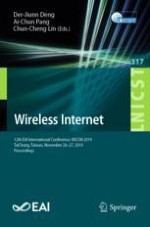2020 | Buch
Wireless Internet
12th EAI International Conference, WiCON 2019, TaiChung, Taiwan, November 26–27, 2019, Proceedings
herausgegeben von: Der-Jiunn Deng, Ai-Chun Pang, Prof. Chun-Cheng Lin
Verlag: Springer International Publishing
Buchreihe : Lecture Notes of the Institute for Computer Sciences, Social Informatics and Telecommunications Engineering
